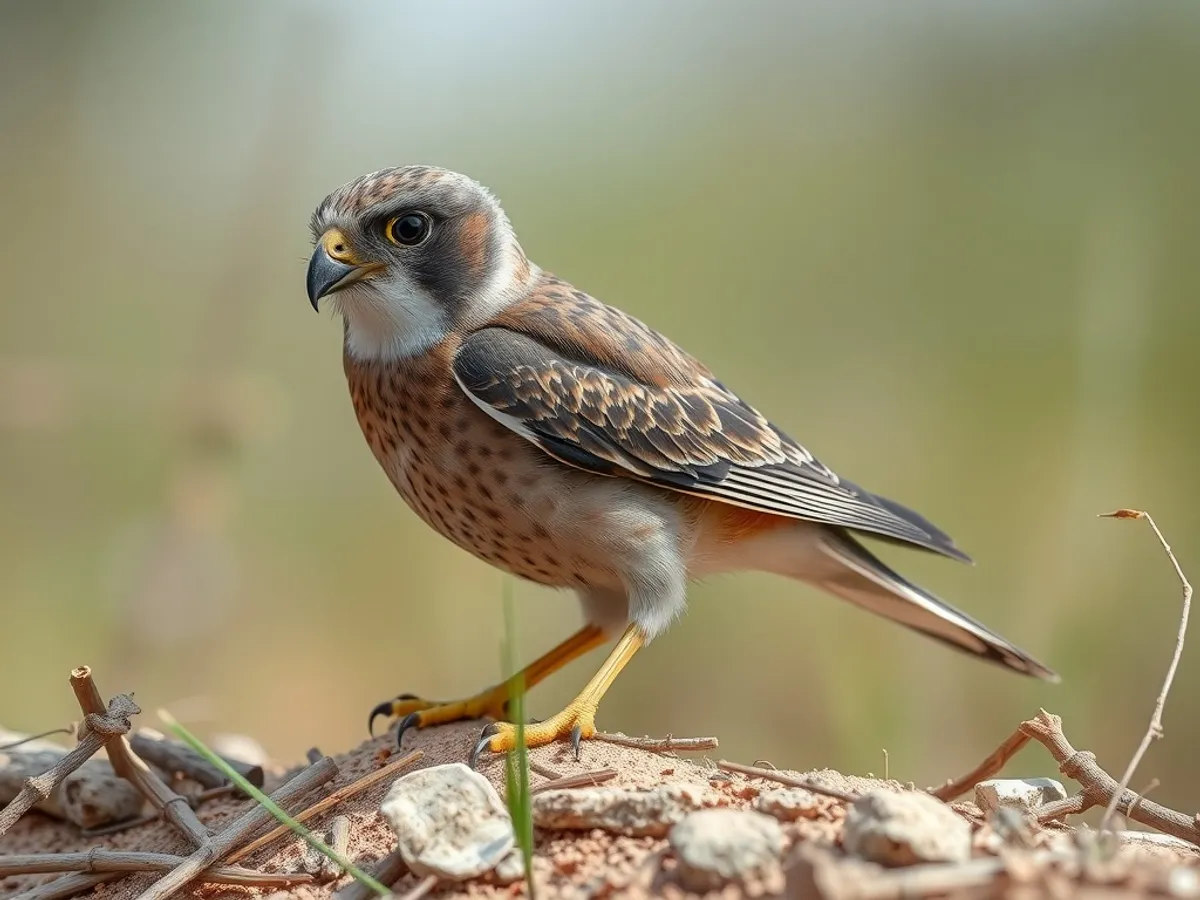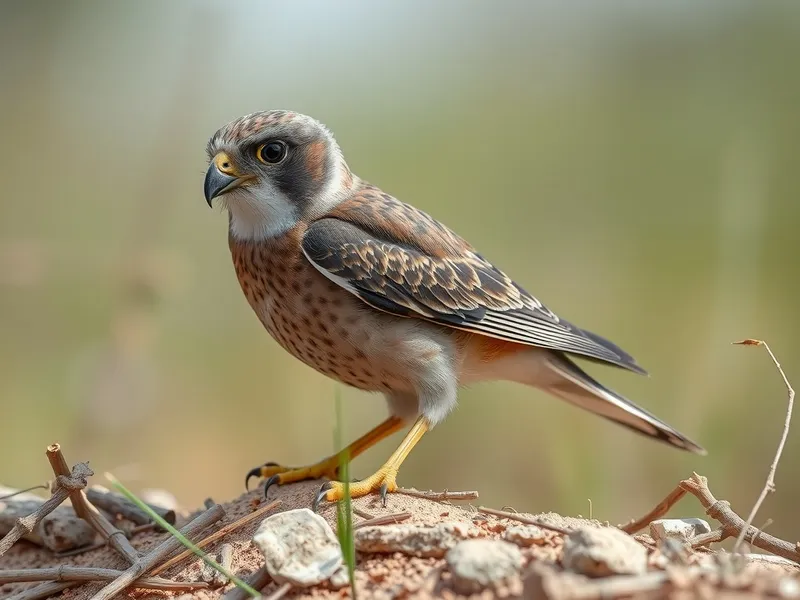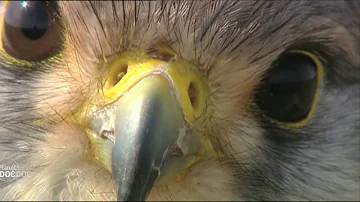
American Kestrel
Falco sparverius

Meet the American Kestrel
The American Kestrel is North America's smallest and most colorful falcon, notable for its rufous back and tail, slate-blue wings in males, and striking facial markings. Agile and versatile, it hunts insects, small mammals, and birds, often seen hovering over open fields or perching on wires. This adaptable raptor thrives in a wide range of habitats, from grasslands and deserts to urban parks. Its diminutive size belies its fierce hunting prowess, earning it the nickname 'sparrow hawk.' The American Kestrel plays an important ecological role in controlling insect and rodent populations.
Classification
Bird
Habitat
Open woodlands, grasslands, agricultural fields, deserts, and urban areas
Diet
Carnivore
Lifespan
3-6 years in the wild
Conservation
Least Concern
Weight
80-165 g
📖Fascinating Facts
Tiny but Mighty
The American Kestrel is the smallest falcon in North America, yet it aggressively defends its territory against much larger birds.
Ultraviolet Vision
American Kestrels can see ultraviolet light, allowing them to track the scent trails left by rodents and other prey.
Urban Adaptability
This species is highly adaptable and often nests in human-made structures in cities and towns, in addition to natural habitats.
📋Detailed Description
The American Kestrel (Falco sparverius) is a small, slender falcon measuring 22–31 cm (8.7–12.2 in) in length with a wingspan of 51–61 cm (20–24 in) and weighing between 80–165 g (2.8–5.8 oz), with females generally larger than males. Its plumage is strikingly colorful: males display slate-blue wings with black spots, a rufous back and tail with a black subterminal band, and two bold black facial stripes, while females have rufous wings and back with heavy barring and a more subdued facial pattern. The kestrel’s eyes are large and dark, adapted for acute vision, and its beak is short, hooked, and equipped with a tomial tooth for efficiently dispatching prey. The legs and feet are yellow and adapted for perching and grasping small animals. American Kestrels are highly agile flyers, capable of hovering in place using rapid wingbeats and tail fanning to spot prey from above. They exhibit sexual dimorphism not only in size but also in plumage, a rarity among North American raptors. Their vocalizations include a rapid, high-pitched 'klee-klee-klee' call, especially during breeding and territorial disputes. Kestrels are solitary or found in pairs outside the breeding season, and they are known for their adaptability to a wide range of habitats, from open grasslands and deserts to urban environments. Their diet is diverse, consisting of insects, small mammals, birds, and reptiles, making them important ecological regulators. The species is highly migratory in northern populations, while southern populations are often resident year-round.
💡 Did you know?
Despite their small size, American Kestrels have been trained in falconry to catch prey much larger than themselves.
🔬Research & Sources
Wikipedia Summary
The American kestrel is the smallest and most common falcon in North America. Though it has been called the American sparrowhawk, this common name is a misnomer; the American kestrel is a true falcon, while the Eurasian sparrowhawk, Accipiter nisus, is not in the Falco genus and is thus genetically unrelated to the American kestrel. It has a roughly two-to-one range in size over subspecies and sex, varying in size from about the weight of a blue jay to a mourning dove. It also ranges to South America and is a well-established species that has evolved into 17 subspecies adapted to different environments and habitats throughout the Americas. It exhibits sexual dimorphism in size and plumage, although both sexes have a rufous back with noticeable barring. Its plumage is colorful and attractive, and juveniles are similar in plumage to adults.
Last Modified: 5/22/2025
🎭Behavior & Social Structure
American Kestrels are diurnal and most active during daylight hours, especially at dawn and dusk. They are visual hunters, often seen perched on wires, fence posts, or hovering in mid-air while scanning for prey. Their hunting strategy involves a combination of perch-hunting and hovering, using exceptional eyesight to detect movement below. Prey includes grasshoppers, crickets, beetles, small rodents, lizards, and occasionally small birds. Kestrels typically kill prey with a bite to the neck using their tomial tooth. Socially, kestrels are generally solitary outside the breeding season but may form loose aggregations in areas with abundant prey. They are territorial, especially during breeding, with both sexes defending nesting sites. Roosting occurs in tree cavities, nest boxes, or building crevices. During cold weather, kestrels may sunbathe to regulate body temperature. They communicate through a variety of vocalizations and body postures, especially during courtship and territorial disputes.
👶Reproduction & Life Cycle
American Kestrels are seasonally monogamous, with pair bonds often forming in late winter or early spring. Courtship involves aerial displays, vocalizations, and food offerings by the male. Nesting occurs in natural tree cavities, abandoned woodpecker holes, cliffs, or artificial nest boxes, as kestrels do not build their own nests. The female typically lays 3–7 eggs (average 4–5), which are creamy to buff-colored with brown markings. Incubation lasts about 26–32 days and is primarily performed by the female, while the male provides food. After hatching, both parents feed the altricial chicks, which fledge at 27–31 days old. Juveniles remain dependent on parents for up to two weeks post-fledging. Breeding season varies with latitude, occurring from March to July in North America, and may be year-round in tropical regions. Kestrels may reuse nest sites in successive years.
🛡️Adaptations & Survival
American Kestrels possess several adaptations for survival. Their keen eyesight allows them to detect ultraviolet light, which helps locate rodent urine trails. The tomial tooth on the upper mandible enables efficient killing of vertebrate prey. Their lightweight, aerodynamic bodies and long, pointed wings facilitate agile flight and hovering. Sexual dimorphism in plumage may reduce competition between sexes by promoting niche partitioning. Their ability to exploit a wide range of habitats, including urban areas, demonstrates behavioral flexibility. Kestrels are cavity nesters, which provides protection from predators and environmental extremes. Their diet shifts seasonally, allowing them to exploit available food resources.
🎨Cultural Significance
The American Kestrel holds significance in Native American cultures, often symbolizing speed, agility, and keen vision. It is admired by birdwatchers for its beauty and adaptability, and is sometimes used in falconry due to its trainability and manageable size. The kestrel is featured in art, literature, and as a mascot for conservation organizations. Its presence in agricultural landscapes is valued for natural pest control, and it serves as an indicator species for ecosystem health.
🔬Recent Research & Discoveries
Recent research has focused on understanding the causes of regional population declines, with studies highlighting the importance of nest site availability and the impact of pesticides. Genetic studies have clarified subspecies boundaries and migration patterns, revealing significant gene flow across populations. Satellite telemetry and geolocator tagging have provided new insights into migratory routes and wintering grounds. Research on urban kestrels has shown behavioral and dietary flexibility, with some populations thriving in cities. Ongoing studies are examining the effects of climate change on breeding phenology and prey dynamics.
🎥Wildlife Videos

American Kestrel Nest Box Study - Full length documentary
RaptorView Research Institute partners with MPG Ranch to study American Kestrel breeding in Western Montana. This film ...
Cherin's Wild Films

KESTREL: The Art in Survival | American Kestrel and Conservation Documentary
I'm so incredibly proud to introduce my first feature-length work: KESTREL: The Art in Survival. This film started as just the story of ...
Meadowlark Video and Productions

Kestrel | HD Documentary
Kestrel documentary recorded in High Definition (HD). The hunt of this bird is very particular, it remains in the still air until it ...
Planet Doc Full Documentaries

American Kestrel
DesertMuseum

Full Story of Kestrel Couple's First Year 🦅 | Full Story | Athena & Apollo | Robert E Fuller
Filmed using cameras hidden inside their nest box, Ash Hollow, this is the real life story of two very different kestrel characters who ...
Robert E Fuller

Kestrel | HD Documentary
Kestrel documentary recorded in High Definition (HD). The hunt of this bird is very particular, it remains in the still air until it ...
Christopher Macdonald
🌍Habitat Information
The American Kestrel typically inhabits Open woodlands, grasslands, agricultural fields, deserts, and urban areas environments. American Kestrels have adapted to their environments with specialized features and behaviors.
Primary Habitat:
Open woodlands, grasslands, agricultural fields, deserts, and urban areas
More detailed habitat information will be available soon.
🛡️Conservation Status
The American Kestrel is currently classified as Least Concern. Conservation efforts are crucial for preserving this species for future generations.
Common Threats:
- 🏠Habitat loss and fragmentation
- 🌡️Climate change impacts
- 🎯Hunting and poaching
- 🏭Human-wildlife conflict
⚠️Threats & Conservation Challenges
While the American Kestrel remains widespread and is classified as Least Concern, populations in some regions have shown declines, particularly in parts of the northeastern United States and Canada. Threats include habitat loss due to urbanization and agricultural intensification, reduction in nesting sites (loss of old trees and cavities), pesticide exposure (notably organophosphates and rodenticides), and competition with invasive species such as European Starlings for nest cavities. Collisions with vehicles and window strikes in urban areas also pose risks. Climate change may alter prey availability and suitable habitat. Conservation efforts focus on nest box programs and habitat preservation.
🔬Scientific Classification
Scientific Name
Falco sparverius
Classification Hierarchy
🔍 About Taxonomic Classification
Taxonomic classification is a hierarchical system used by scientists to classify and organize living organisms based on shared characteristics and evolutionary relationships.
The system moves from broad categories (Kingdom) to increasingly specific ones, with each animal's scientific name typically consisting of its Genus and species.
📝Community Notes
Share your observations and insights about the American Kestrel with our community of wildlife enthusiasts.
Join Our Community
Sign in to share your observations and connect with fellow wildlife enthusiasts.
Sign In to ContributeNo community notes yet
Be the first to share your observations about the American Kestrel!
Explore American Kestrel
Select a tab above to learn more about this amazing animal.
📸Photo Gallery
No photos available for this animal yet.
🌟Discover More Wildlife
Continue your journey of discovery with more fascinating animals from our database
